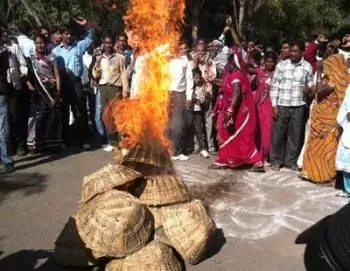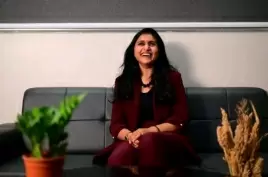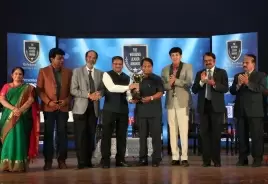Rehabilitation remains a challenge as the issue is not just economical or social

01-February-2013
Vol 4 | Issue 5
A yatra by 500 dalit and Haila Muslim safai karmacharis to motivate other women to give up the practice of manual scavenging and burn their brooms and baskets, will culminate in Delhi on January 31. The other leg of this journey requires a society that perpetuates this practice to shake off its caste bias
“Eleven thousand women in Madhya Pradesh have shunned the ‘unclean’ practice of manual scavenging. Five hundred women will be embarking on a yatra across 18 states and 200 districts to motivate other women to give up the practice!
 |
|
The process of rehabilitating the manual scavengers begins with burning of their baskets (Photo: Infochange News & Features)
|
Friends, we have gathered here to inaugurate the yatra,” boomed the voice of the compere at Ravindra Bhavan, Bhopal, in November 2012.
At the event, slogans were shouted, folk musicians sang, chief guests were welcomed. The ceremonial lamp was lit. Speeches were delivered. Two women ‘liberated’ from the practice were honoured. Photo-ops were staged. And cameramen competed for space.
The Maila-Mukti Yatra, a journey to be free from manual scavenging, inaugurated at Ravindra Bhavan in Bhopal, is led by Rashtriya Garima Abhiyan (National Campaign for Dignity and Elimination of Manual Scavenging), which is a network of human rights organisations striving to eradicate manual scavenging.
The Abhiyan (launched in Dewas district, Madhya Pradesh since 2001) endeavours to motivate dalit women and Haila Muslim families to give up manual scavenging and oppose all forms of caste oppression and discrimination.
The Employment of Manual Scavengers and Construction of Dry Latrines (Prohibition) Act 1993 officially forbids the practice of manual scavenging and the continuance of dry toilets. Regardless, women and men continue to be employed as ‘manual scavengers’. While the majority of ‘manual scavengers’ are women, several men too are forced to render this labour.
The efforts of the Abhiyan in the last 12 years have been aimed at making dalit and Muslim women aware of their rights, organising them into sangathans (collectives) which enable them to better negotiate their rights, and calling for their psycho-social, political and cultural rehabilitation. Journeying across 18 states (Uttar Pradesh, Bihar, Jharkhand, Gujarat, Maharashtra, West Bengal and Karnataka, among others), the yatra will culminate in Delhi on January 31, 2013.
At Ravindra Bhavan, a busy volunteer, a round-faced woman called Arti, was one of the two women honoured for their courage in deciding to ‘burn the basket’. Arti, now a volunteer with the Abhiyan, was born into a Valmiki family in Damoh town, Madhya Pradesh.
For those unfamiliar with occupational segregation based on caste, the Valmiki community dalits are placed at the bottom of the caste hierarchy. They are socially ostracised and discriminated against because they have historically been compelled by their caste to render menial labour -- disposing of animal carcasses and human and animal faeces, assisting in childbirth and in morgues, castrating animals, beating drums at funerals, cleaning drains and septic tanks, and sweeping.
Arti, aged 35, matured into adulthood watching her mother receive a pittance and a few rotis in lieu of manually disposing the excreta of upper-caste residents in Damoh town. She dropped out of school at a young age to help her mother with the intention of ameliorating the hereditary burden. After marriage, her mother-in-law, continuing a common wedding ritual, bequeathed her basket and broom to Arti. This effectively meant that Arti would clean all the dry toilets her mother-in-law used to clean.
“Since manual scavenging has continued over the centuries and generations, we could not think beyond it. ‘Hamari soch bahut chhoti thi’(our perspective was narrow),” said Arti.
She credited Rashtriya Garima Abhiyan with liberating her from this “mental slavery” (mansik jakad). Recalling earlier interactions with members of the Abhiyan, Arti noted: “They told us that our experience of untouchability and discrimination was rooted in our continued association with handling human excrement. If we refused to do it, we would not be discriminated against.”
The outcome of her resolve, she narrated, was the gradual respect and dignity she and the other women earned. Feeling vindicated, she declared that the local police who earlier admonished them could no longer refuse to acknowledge their presence.
“We can even draw water from the local handpump now,” Arti said with a triumphant smile.
Several women gathered at Ravindra Bhavan corroborated Arti’s account of fewer experiences of discrimination and untouchability since they had discarded their baskets. A woman confessed that it was challenging for her to believe that her children shared the same playground with children from upper-caste families.
Another woman described it as a psychologically uplifting period in her life in which she no longer had to hurry past upper-caste dwellings, fearing rebuke. She was thankful that her everyday mobility was increasingly becoming unhindered. Both the women, although sceptical about the changes occurring in their lives, recognised that it was profoundly entrenched notions of purity and pollution that formed the basis of the behaviour of upper castes.
At Ravindra Bhavan, folk musicians and the lyrics of their songs encouraged women to shun the practice. One woman broke into a spontaneous dance, turning full circle on the ball of her left foot in sync with the song’s rhythm. She was uninhibited. She was happy. The other women cheered her on.
But the celebratory air was suffused with a sense of contradiction. Behind the hearty sloganeering and occasional smiling faces of women who had apparently been ‘liberated’ from the practice were voices and stories rife with insecurity and worry arising from loss of livelihood.
“How long can I survive with no work?” “What work will we get?” It was with the expectation of gaining alternative work that many women had decided to attend the event. Armed with photocopies of grievance letters, property documents, or hand-written notes of request suitably thumb-imprinted by family members, this was a rare opportunity for the women to personally hand over the documents to Chief Minister Shiv Raj Singh Chouhan, one of the chief guests at the event.
Arti was upset that out of a thousand women gathered at the venue, not even five had been ‘rehabilitated’. Several others had, as is frequently the case, relapsed into picking up their brooms and baskets; the majority were jobless.
The gathering comprised a mixed bunch of married women (young, middle-aged, elderly), single women (elderly, middle-aged widows without a pension, unmarried and separated women with no family support), adolescent girls who had been recently handed baskets to continue the practice, and a small group of men who had given up this work or ‘freed themselves’ from cleaning septic tanks and drains.
For most of the women and men who are not organised into sangathans or have not ‘graduated’, like Arti, to becoming volunteers with the Abhiyan, survival without a source of livelihood is daunting.
Fear of aggression by members of the upper castes resistant to change in the caste order is a recurring threat for many. They also continue to experience frequent instances of untouchability. Even for women organised into sangathans, discrimination in securing alternative livelihoods is widespread and humiliating.
A group of women at Ravindra Bhavan expressed their desire to work at anganwadi centres in and around the village. However, they quickly noted that their wish would remain a dream. “How will we get work at anganwadis,” they asked, disheartened that they were unlettered and untrained. The minimum educational qualification required for an anganwadi worker is Class 10 or a matric pass, and for an anganwadi helper it is basic literacy.
The Self-Employment Scheme for Rehabilitation of Manual Scavengers 2007, with provisions for training and loans, is the principal scheme for the rehabilitation of ‘manual scavengers’ to alternative jobs. It used to be called the National Scheme for Liberation and Rehabilitation of Scavengers (NSLRS) 1991-92.
The ‘manual scavengers’ are also eligible for loans at concessional rates of interest from the National Safai Karamchari Finance and Development Corporation.
The new Bill on manual scavenging pending in Parliament, retains the above provisions and makes three new additions -– a photo identity card, residential plot, ready house or financial assistance for construction (subject to eligibility), and livelihood skills-training for one member of the family.
In addition to these specific schemes, ‘manual scavengers’ can also invoke several welfare measures under the Scheduled Caste Sub Plan (SCSP) 1979, Special Central Assistance (SCA) for below-the-poverty-line (BPL) scheduled caste families, Scheduled Castes Development Corporations in the states and reservations for scheduled castes in government jobs and educational institutions.
Regretfully, the existence of these myriad schemes and provisions offers little comfort to the deprived. Low literacy levels among the ‘manual scavengers’ and absence of legal assistance translate to lack of information and awareness about government schemes for the community and for scheduled castes in general.
Moreover, availing of loans (especially under the SRMS) is a bothersome process requiring ‘manual scavengers’ to secure the backing of a government guarantor. In addition to inordinate delays, lack of transparency and corruption, the repayment conditions of loans push the safai karamcharis and their families into an inevitable cycle of debt.
The report of the Comptroller and Auditor General (CAG), which reviewed the NSLRS, stressed that the scheme had failed to achieve its objective in the last decade. Funds available under it were either unspent or unused and there was no evidence to suggest that those ‘liberated’ had been rehabilitated. Even though the majority of manual scavengers are women, the scheme has predominantly benefited men.
“A one-time rehabilitation grant (under SRMS), which neither reaches us nor helps us rehabilitate ourselves, allows the state governments to claim on paper that manual scavenging has stopped and people have been rehabilitated,” Arti said. The truth, she argued, was that state governments and local officials siphoned off the money year after year, refused to register complaints and never penalised either dry toilet owners or erring public officers.
Arti and the other women expressed the wish that cash be directly transferred to the gram panchayat. “We can negotiate with our gram panchayat but cannot keep running to the nagar palika,” she said.
What do we understand by ‘rehabilitation’ of ‘manual scavengers’? The first words that come to mind are self-employment loans, concessional loans, scholarships, subsidies and alternative jobs. For international NGOs and development organisations, rehabilitation means a rigidly defined ‘targeted intervention’ to ‘empower manual scavengers’ in a few odd districts in one state.
Would the language of economic rehabilitation so often deployed by policymakers meaningfully rehabilitate a woman and her family if ‘rehabilitation’ were to be understood as a call for dignity, a plea to lend a patient ear, to not dismiss their concerns as unimportant? Away from the politics of money, what if we rethought rehabilitation as a demand for respect, freedom from deep-seated caste condemnation, an end to humiliating experiences of untouchability and an opportunity to earn a dignified living?
How would our understanding of rehabilitation change if the problem was reframed as ‘scavenging’, not ‘scavengers’?
The most fundamental change called for here is to broaden the scope of rehabilitation to include us, the middle classes (as widely defined as possible) as target groups for change. Much greater persistence than that needed to convince women to shun the caste-enforced practice is essential to stir, awaken and alert the middle classes to acknowledge our role in the perpetuation of manual scavenging.
This significant section of the population remains greatly distanced from the ignominy and exploitation associated with handling faecal discharge. Our distance, far from being neutral, in fact fuels the apathetic discourse around the dignity and rights of ‘manual scavengers’. Stirring our middle-class conscience to recognise our prejudices (organised along both caste and gender) is an enormous task.
That is because this prejudice is a malaise that not only infects our minds but, by extension, our institutions of justice and decision-making, workplaces, schools, universities and our polity. Since institutions are constituted of individuals, the structural change and systematic overhaul that we desire has to begin in our minds.
Laws and government schemes, important in themselves, can offer economic rehabilitation, but the process of restoring the dignity of and securing psychological and social liberation for those employed as ‘manual scavengers’ has to start with us, in our everyday conversations.
(Agrima Bhasin is a researcher at the Centre for Equity Studies, a New Delhi think-tank engaged in research and policy advocacy on issues of social and economic justice. This is the first in her series on safai karamcharis researched as part of the Infochange Media Fellowships 2012) - Infochange News & Features














